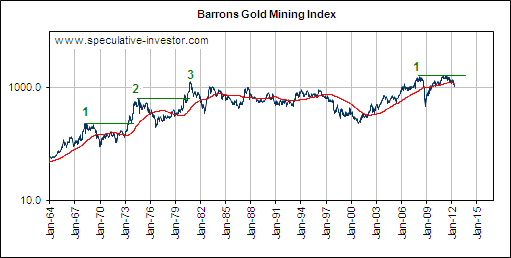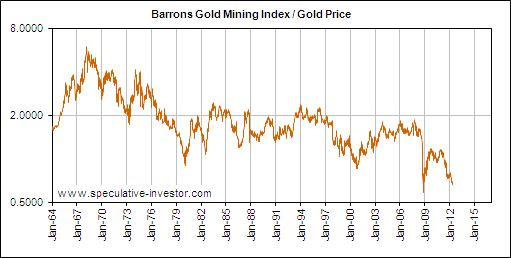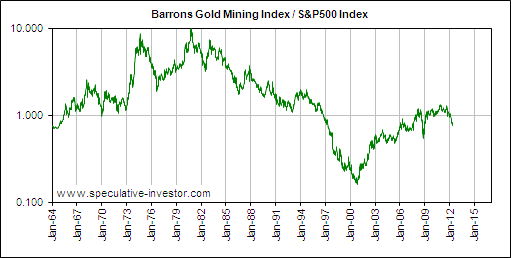Gold Stocks: The Big Picture
It's time to update our long-term weekly charts showing how the gold sector, as represented by the Barrons Gold Mining Index (BGMI), has performed in US$ terms, gold bullion terms and S&P500 (SPX) terms.
The first of our long-term charts shows the BGMI since 1964 and includes a 200-week moving average (the red line). The peaks of the three major rallies that composed the 1960s-1970s bull market are labeled "1", "2" and "3". A visual comparison of the current bull market and the bull market of the 1960s-1970s suggests that the early-2008 peak is equivalent to the early-1968 peak. Consequently, the early-2008 peak has also been labeled "1".

From the above chart we observe that the distance between major peaks during the bull market of the 1960s-1970s was 6.0-6.5 years, and that following a major peak at least 5 years went by before the BGMI broke decisively into new high ground. If the current bull market follows a similar pattern then the next major peak will occur in 2014 and a decisive break to new highs won't occur until the first half of 2013.
The second of our long-term charts shows the BGMI/gold ratio over the same period.

Relative to gold, the BGMI was in a major bear market from early 1968 through to January of 1980 (the bottom for the BGMI/gold ratio exactly coincided with the peak for gold bullion). The only significant interruption to this bear market was during 1973-1974, which, by the way, was a period of substantial weakness in the broad stock market. In other words, there is historical precedence for gold stocks trending upward in nominal terms and relative to gold bullion while the broad stock market trends downward.
Bear in mind that the BGMI is a proxy for senior gold mining stocks. Its performance relative to gold therefore shows that the senior gold mining stocks generally underperform the bullion during the course of a long-term gold bull market. This is a point we have made numerous times in TSI commentaries over the years. It is why we have had no direct exposure to senior gold mining stocks since early 2004 and why we are not interested in such stocks today (other than as short-term trades).
We are interested in junior gold and silver mining stocks (producers and explorers) and we are interested in the metals themselves, but we aren't interested in anything in between. If we want additional leverage to the bullion we'll buy the juniors; if we want additional non-leveraged exposure to the bullion we'll buy the bullion.
Obviously, our concentration on the junior end of the market hasn't worked well of late. As far as we know, everyone who has concentrated on the juniors has done poorly over the past 12 months and especially over the past 8 months. It has been an unusually difficult period for these types of stocks. However, our concentration on the junior end of the market has served us very well over the past 10 years and is likely to serve us well over the remainder of gold's long-term bull market.
The last of our long-term charts deals with the BGMI/SPX ratio (the gold sector's performance relative to the broad stock market).

The decline in the BGMI/SPX ratio over the past year doesn't look like much on our long-term chart and is small relative to some of the declines that occurred during the 1960s-1970s bull market, but it resulted in the weekly RSI (an intermediate-term momentum indicator) hitting a 10-year low.
Above is an excerpt from a commentary originally posted at www.speculative-investor.com on 20th May 2012.
Regular financial market forecasts and analyses are provided at our web site: www.speculative-investor.com/new/index.html
We aren't offering a free trial subscription at this time, but free samples of our work (excerpts from our regular commentaries) can be viewed at: www.speculative-investor.com/new/freesamples.html






 Steve Saville graduated from the
Steve Saville graduated from the 









